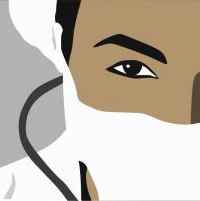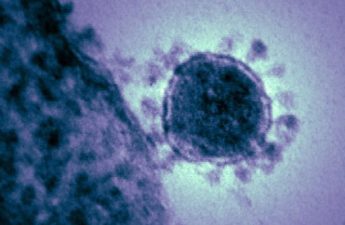By Dara Lind, ProPublica

As hospitals across the United States brace for a difficult six months — with the first wave of the coronavirus pandemic still raging and concerns about a second wave in the fall — some are acutely short-staffed because of an ill-timed change to immigration policy and its inconsistent implementation.
A proclamation issued by President Donald Trump on June 22, barring the entry of most immigrants on work visas, came right as hospitals were expecting a new class of medical residents. Hundreds of young doctors were unable to start their residencies on time.
Trump’s order included the H1-B visa for highly skilled workers, which is used by some practicing doctors abroad who get U.S. residency slots. The proclamation stated that doctors “involved with the provision of medical care to individuals who have contracted COVID-19 and are currently hospitalized” should be exempt from the ban, but it delegated the issuing of guidance to the departments of State and Homeland Security. That guidance has been slow and inconsistent.
Many consulates started approving doctors’ visas on Thursday, after ProPublica asked the State Department about the delay. Others say they’re still awaiting guidance.
At hospitals where many incoming residents are visa holders, even a delay of a few weeks in arriving in the U.S. creates a staffing crisis. Doctors and administrators are afraid that the repercussions will last for the rest of the year — leaving them overworked and ill-prepared even before a second wave of the virus hits.
ProPublica is a Pulitzer Prize-winning investigative newsroom. Sign up for The Big Story newsletter to receive stories like this one in your inbox.
ProPublica has heard from 10 would-be medical residents stuck abroad because of H1-B visa issues. Six of them had gotten emergency consulate appointments for visa approval, but when they arrived for meetings they were told their visas could not be approved. Three were still waiting on DHS approval for their visas, a necessary step before a visa gets a consulate stamp. One resident had application approval but was denied an emergency consulate interview appointment because of the ban. All were destined for hospital positions treating COVID-19 patients.
The State Department told ProPublica on Tuesday that it, “in conjunction with the Department of Homeland Security and interagency partners, is establishing and implementing procedures” for the visa ban, and that it “has communicated and will continue to communicate implementation procedures” to consulates abroad.
On Thursday, the State Department’swebsite posted guidance, spelling out that doctors treating COVID-19 patients were exempt from the ban. On that day, many of the residents ProPublica spoke to said they had suddenly received visa approvals. “A quite remarkable turnaround, given that I received a rejection email three days ago,” one said. In at least five countries, however, consulates were still not processing doctors’ visas.
The Committee of Interns and Residents, an affiliate of the Service Employees International Union, has heard from over 250 interns stuck abroad. Over 150 of them are on H-1B visas.. (The others are on visas that weren’t covered in Trump’s ban, but can’t get approval because their consulates are still closed due to the pandemic.) Union president Jessica Edwards pointed out to ProPublica that while that number may sound small, each intern is responsible for the care of thousands of patients.
As of 2017, there were 2,532 medical residents on H1-B visas, according to the Journal of the American Medical Association — though the Trump administration’s continued restrictions to legal immigration may have made it less appealing for hospitals to sponsor visas in the last few years. But the impact on hospitals is highly concentrated in the less-prestigious hospitals that tend to rely on residents from overseas.
At one New York City hospital serving low-income residents, nearly half the incoming class is still stuck abroad, multiple sources confirmed to ProPublica. One hospital in a large Midwestern city told ProPublica that “roughly half” of its first-year doctors started on time. In the Deep South, a region now overwhelmed by COVID-19 cases, a doctor who was set to start told ProPublica he was among 10 residents still awaiting visa approval as of early July. All hospitals and doctors spoke to ProPublica on the condition of anonymity because they worried about jeopardizing their visa applications.
ProPublica has also spoken to more-experienced doctors facing the same issue — including an infectious-disease specialist blocked from starting a job in an area of the Western U.S. where COVID-19 cases are rising.
When there aren’t enough incoming residents to replace departing third-year residents, staffing crunches result.
At the New York City hospital, a doctor told ProPublica that after only 10 days of short-staffing, one resident had called in sick from exhaustion. The doctor recounted a recent shift in which there had only been two junior residents on call, compared with the typical six. Even by having residents work individually instead of in teams of two, they couldn’t keep up with new patient admissions.
“The patients had to just stay there waiting in the (emergency department) for the residents to finish their first admission, in order to see them,” the doctor said. “When the shift was over, I logged into the computer and I would see notes written at 10 p.m., 11 p.m. And these residents are expected to go home and then come back again at 6:30 a.m.”
Even at hospitals with decreasing COVID-19 caseloads, short-staffing is a bigger problem than it was in pre-pandemic times. Some hospitals are seeing a “surge of non-COVID patients” who were unable to get care for chronic conditions like heart disease during lockdown and are now deteriorating, a doctor at a short-staffed hospital told ProPublica. And because protocols prevent doctors from switching back and forth between COVID-19 and non-COVID-19 patients, the hospital needs to keep more doctors on-call to maintain staffing levels in both wards.
“If someone is getting acutely ill, who will see them?” a hospital administrator told ProPublica. “I’ve got my poor residents running around trying to make sure everyone is seen in a timely manner. And residents are great, but they can only be in one place at one time.”
Some of these problems will be fixed as residents receive delayed visa approvals and are able to come. But it will take weeks, if not months, to successfully onboard them. The Midwestern hospital anticipates that arriving residents may not be able to start until mid-August. In the meantime, they’re understaffing services and using fourth-year medical students in place of residents.
Hospitals are used to a summertime efficiency gap, as new interns learn the ropes. This year, it could persist into fall — when a second wave of coronavirus infections is expected.
“I’m really worried that in three months,” said the medical administrator, “we’re going to have a bunch of residents who are just exhausted and just getting into the worst part of the fall, flu and COVID season.”
These doctors already had to push themselves through the first wave of COVID-19 this spring. Furthermore, at hospitals hardest hit by the visa ban, the residents picking up the slack are often themselves H1-B visa holders whose futures are now uncertain. Trump’s ban didn’t revoke visas for anyone currently in the U.S., but if they leave the country — which they will have to do if they change jobs — their ability to return is unclear. Some of the doctors interviewed by ProPublica were living in the U.S. before the pandemic and returned home partly to get visa approval for their new jobs. One doctor ended up stuck in India while her husband was unable to travel there from the U.S.
Another doctor from India, now working in the U.S., told ProPublica: “My parents, they’re (in India) by themselves, and both of them are about 70. At some point, probably, they will catch the infection.” If that happens, the doctor plans to leave the U.S. to care for them — “and if I don’t come back, I don’t come back. At this point, I really don’t care.”
The feeling that the U.S. doesn’t value them is compounded among residents who’ve already lived through the first wave of COVID-19 and who are now facing overwork and visa uncertainty. Some said other countries are making it easier for doctors to immigrate, while the U.S. leaves them in limbo.
“We feel underappreciated for what we’re doing,” the New York City resident said. “And what else can you do, more than sacrificing your life?”
Tightly regimented residency schedules can be tricky for H1-B visa holders even in the best cases. Doctors find out in mid-March if they are “matched” with a U.S. hospital, where they’ll be expected to start at the beginning of July. DHS often takes longer than that to approve H1-B applications. Employers can pay for expedited processing to guarantee a decision within five days — but DHS shut down its expedited processing on March 22 because of COVID-19 and didn’t reopen it until June 8.
Shortly afterward, Trump issued his proclamation banning entries on many visa types, including the H1-B.
Most people coming to the U.S. for residencies arrive on a different kind of visa, the J-1, and aren’t covered by Trump’s ban, though some have had issues getting consulate appointments because of the COVID-19 pandemic. But doctors do identical work regardless of their visa types. If anything, doctors with H1-Bs are more qualified than those with J-1s, since they’re required to have completed all three phases of the taxing U.S. Medical Licensing Exam before starting residencies. Residents with H1-B visas were practicing doctors in their home countries, working alongside new medical-school grads from the U.S.
An earlier immigration ban targeting permanent immigrants, which passed in March, contained a broad medical worker exemption. When rumors of a work-visa ban started swirling in late spring, immigration lawyers and hospitals expected it would include the same language. Instead, the June proclamation mentioned only doctors working with hospitalized COVID-19 patients.
Every resident who spoke with ProPublica had provided evidence to the U.S. government that they met that description. Some were told by consular officers that they were probably exempt. But until they received State Department guidance, they had to place their visas in “administrative processing” — an indefinite holding pattern.
ProPublica saw an image of a form given to one visa applicant informing them of a hold. The form is typically used to request more information from the applicant. In this case, though, a consular officer had modified the form to say that processing would not begin until “implementation procedures” for the visa-ban exemption had been provided.
Doctors in limbo have formed WhatsApp groups to share information and support, but the dialogue has shown inconsistencies in the ban’s implementation. Some consulates, such as those in Serbia, Russia and the United Arab Emirates, have approved doctors’ H1-B visas as exempt. Asked about the discrepancy, the State Department told ProPublica: “Applicants who believe they qualify for an exemption from Presidential Proclamation 10052 should check the website of the closest U.S. Embassy or Consulate regarding the current status of services. How appointment systems are managed can vary depending on the consular section.”
One applicant who reached out to the State Department for assistance received an email reply from an employee on July 10. The employee said that as far as they knew, the Office for Consular Affairs had given guidance to consulates and embassies to process visas that were exempt from the ban. (The agency declined to comment on that email.)
On Thursday, that applicant received a second email from the same employee. Guidance had been slow in coming, the employee admitted, but it had finally come through.
But some countries still haven’t changed their practices. One doctor stuck abroad told ProPublica they’d sent a follow-up email to the consulate on Thursday morning. “He gave me the same reply,” the doctor said, “that they are still waiting for guidance from Department of State.”


